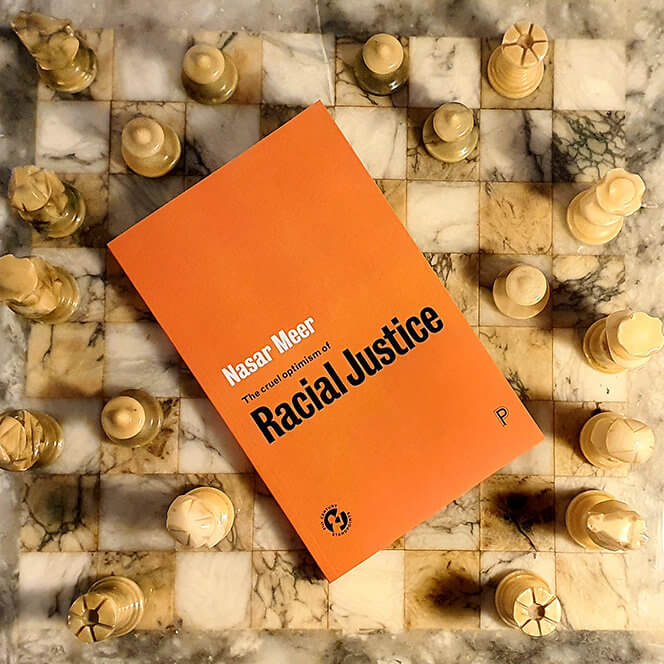What can we learn from reflecting on the fate of racial justice in the UK and elsewhere in the Global North? To ask this question is to reckon with something that antiracist researchers, activists and policy makers have often made a difficult peace. Namely, a cruel optimism that racial justice inevitable progresses. My new book contributes a response to this in two ways.
Racial Justice as Theory and Practice
The first foregrounds sociological understandings of anti-racism, racial inequality, racial formation and racialization. Each feature in, and often give content to, appeals for racial justice and yet are often treated as distinct. In this respect The Cruel Optimism of Racial Justice takes up the late Charles Mills’ invitation to examine racial justice outside the realm of ideal theory. We might say that Mills turns John Rawls on his head to ask ‘not how you would create an ideal basic structure from ground zero but how you would dismantle an already existing unjust basic structure’ (Mills 2017, p. 213). I follow this move but fold racial justice into a tradition or rather than a single theory, to re-inscribe the idea of racial justice with sociological content. Doing so shows us how racial injustice is often co-constituted across different social domains and ancillary social spheres.
This also challenges Mills, however, specifically in his seeing racial justice as ‘primarily not pre-emptive measures to prevent racial injustice but corrective measures to rectify injustices that have already occurred’ (Mills 2013, p. 2). My argument is that racial justice is multi-temporal in traversing that which has happened in the past, that which is manifest in the present, as well as that which will likely occur in the future. In so doing, I join and expand a presently US-centred critique of the idea of ‘progress’ in racial justice as something societies are ‘gradually moving toward…through incremental reforms or social action’ (Seamaster and Ray 2018, p 316).
Optimism’s Double Bind
My second core argument is that there is no likely end to the struggle for racial justice, only the promise this heralds and the desire to persevere, even despite knowledge of likely failure. Drawing from Lauren Berlant’s influential account of the cultural logic at work in an increasingly unachievable post-war promise of the good life, allows us to see how such a view of progress ultimately rests in ‘optimism’s double bind’, where ‘an image of a better good life available’ creates an impasse that does not easily allow us to ‘detach from what is already not working’ (Berlant, 2011, p 263). It is through Berlant, who also sadly passed last year, that we find a second answer to the opening question of what we can learn from the accumulated struggle for racial justice in the UK and elsewhere in the Global North.
To ground this for a moment, we might observe how in Britain some racial disparities are demonstrably getting worse. Take the claim that ‘in the last decade, the extent to which black children and young people are disproportionately targeted by the youth justice system has increased’. The social domains this spans (e.g., education, welfare, criminal justice, labour market) is precisely what is obscured unless a system wide view adopted. This is easily substantiated in youth justice statistics for 2018/19 in England and Wales, which show that Black children (who make up about 4 per cent of the entire population aged between 10–17 years) are four times more likely to be arrested than their White counterparts, and nearly three times more likely to receive a caution or custodial sentence. In 2019 the percentage of Black children in custody had significantly increased to 28 per cent of the entire population held in youth custody (compared with 15 per cent a decade previously) (Youth Justice Statistics, 2018/19, p 42). This is one amongst a number of racially disproportionate outcomes that have worsened despite our desire to remain optimistic to contrary – ‘a possibility that also risks having to survive, once again, disappointment’ (Berlant (2011, pp 121–2).
Crisis Ordinariness or Breaking Clear?
This should not be read as an admission of naivety or misplaced faith in the hope for change, or of having been ‘hostage to the belief that everything is going to improve or turn out well’ (Back, 2020 p. 7). If anything, it is to chronicle how, in and against historical contexts, racial minorities have continued to mobilise while refusing the status of beleaguered objects of oppression, something that invokes a range of strategies, debates and intellectual chains.
As Hague (2020) has put it, ‘one has to have an incredibly impoverished sense of political efficiency if one fails to see that “speaking truth to power” is not just one action but a whole strategic field that requires knowing when and how to do so’. The cruel optimism of racial justice is necessarily dispersed across a field and in a constant struggle for something better, something possible, perhaps most keenly expressed in Neville Lawrence’s statement to the Macpherson Inquiry (1999) into the racist murder of his 17-year-old son, Stephen Lawrence. ‘We have to look forward’, he insisted, speaking through grief. ‘This is a very small place, this world of ours, we have to live together and we now have to say; let us put the past behind us, join hands and go forward’ (quoted in Macpherson 1999, para 4:12).
These words, spoken by a parent surviving bereavement, remain a profound call for a better society, one greater than that which so cruelly took his son, but which, some twenty years later, remain unheeded. These words remind us how the past then, as the past now, is as ahead of us as much as it is behind us. For, in the findings of her inquiry into racial inequality and the COVID-19 pandemic, where ‘Black, Asian and minority ethnic people have been overexposed, underprotected, stigmatised’, Stephen’s mother Baroness Doreen Lawrence issued another call to ‘break that clear and tragic pattern’ (Lawrence, 2020 p. 4). Her report documented that ‘the impact of COVID-19 is not random, but foreseeable and inevitable – the consequence of decades of structural injustice, inequality and discrimination that blights our society’ (ibid).
What Berlant’s motif helps us to see, in this example and others, is that shocking racial equalities may appear traumatic when accounted for at one moment, but those of us in the pursuit of racial justice have long adapted to ‘a notion of systemic crisis or “crisis ordinariness”’ (Berlant 2011, p 10).
If this is the same motive that binds us into a cruel optimism presently, this need not be our future too.
You can watch Nasar talk about The Cruel Optimism of Racial Justice in his plenary at the BSA Annual Conference on Wednesday, 20 April 2022 from 1-2pm. Registration closes on Sunday, 10 April 2022.
Nasar Meer is Professor of Sociology and Director of RACE.ED at the University of Edinburgh.


